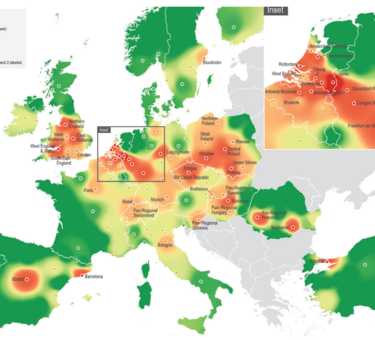
Logistics Real Estate Network Expansion
E-commerce is booming, logistics hot spots are shifting and global supply chains are being restructured. So how are decision-makers responding?
In our most recent survey, Prologis Research and EFT polled logistics industry participants in Europe to see how new real estate footprints are being developed. The survey, which was first conducted in 2013 and then repeated over the past few months, revealed the most important factors driving location selection, as well as the current European logistics hotspots (and a few locations that have dropped in importance). Our survey also shines a light on how decisions have evolved over the past two years.
Our survey uncovered four key insights:
- What drives favorability Key factors shaping location choice include proximity to economic centers and the presence of modern and efficient infrastructure. Positioning to serve global trade routes is also important.
- The most desired locations Favored locations include those within the Benelux and in Central and Eastern Europe (CEE). Many of these locations are oriented along international and global trade flows and are near Europe’s major consumer markets.
- How will location choice change Users remain laser-focused on modernizing their supply chains and, for many, this means augmenting their networks with facilities that have pan-European capabilities. Looking forward, users are concerned about the availability of labor, the ongoing expansion of global trade volumes and changes in infrastructure.
- E-commerce and sustainability are increasingly the name of the game Logistics locations and facilities best-positioned to meet e-commerce and sustainability requirements have a measure of futureproofing at work. Relative to our study two years ago, users notably increased their emphasis on these factors to make decisions.
What does it all mean? For policy makers, our study encourages infrastructure and labor force policies that attract logistics businesses. For users, the primary consideration is the availability of labor. While ample today in some markets, that may change as unemployment eventually normalizes. Also users should maintain a focus toward e-commerce. These efforts will certainly be rewarded. For investors, our study conveys a greater understanding of how customers may augment their networks in the coming years, although long-term value creation also follows from constrained supply.
INTRODUCTION
Prologis partnered with Eyefortransport (EFT) to explore industry perceptions on the most desirable logistics locations in Europe and to quantify the criteria which influence site selection. Warehouse users (216 respondents) from a range of sectors—from retail to automotive to pharmaceuticals— were asked by EFT to share their views by ranking 100 locations against eleven criteria. Responses cover areas including (i) key logistics location selection criteria, (ii) the most desirable logistics locations in Europe today, and (iii) key demand drivers of the future. Our paper follows this outline.
SECTION 1: WHAT DRIVES FAVOURABILITY?
Favour proximity and transportation. We surveyed customers across eleven different location criteria. While most criteria earned scores above 3.5 on a 5.0 scale, implying elevated importance across most categories, the responses for leading categories should come as no surprise to seasoned site selection professionals. In summary, users favour closeness to economic networks, low costs (both transport and real estate costs) and an availability of skilled labor. At the other end of the spectrum, incentives play less of a role (although still earning a score above 3.0 on a 5.0 scale).
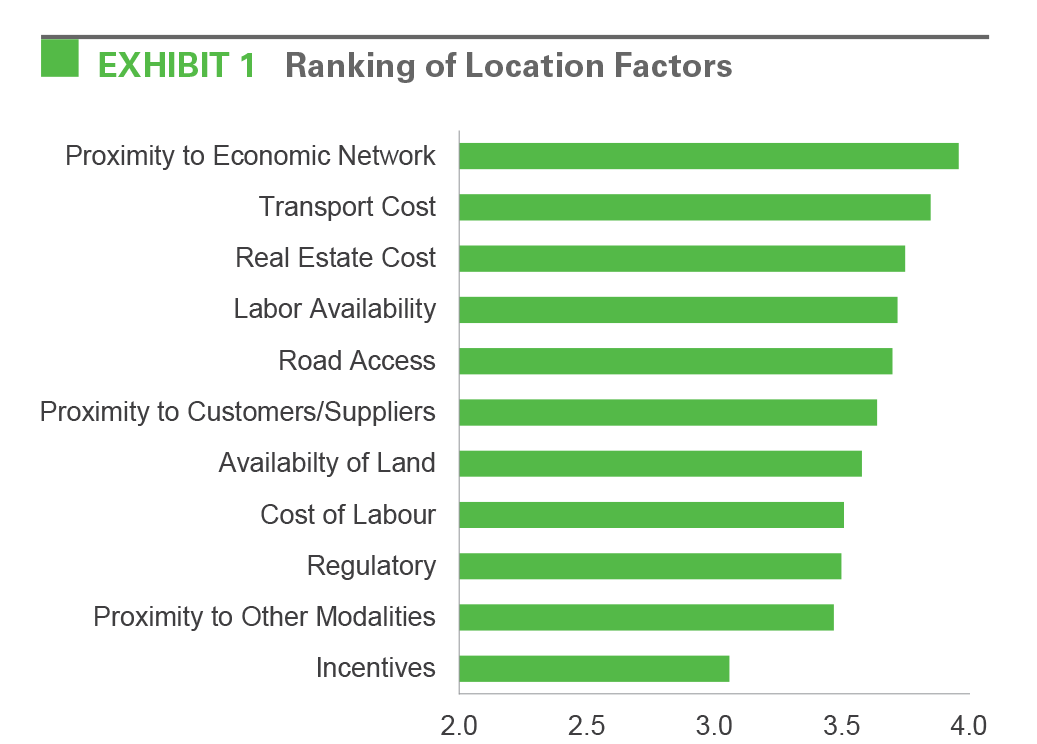
Importance of location criteria differ across the different verticals. “Transport cost” is the most important location driver for the auto, high-tech and manufacturing industries, while retail sees “labor availability” and “proximity to customers & suppliers” as the most important location criteria. The pharma sector ranks barriers regarding “regulations” higher compared to the other sectors.
Subtle shifts in customer location preferences. In comparison to 2013, infrastructure and real estate requirements rose in importance as a location driver. For instance, the criterion “proximity to different types of modalities” scored 33% higher in comparison to 2013. On the other hand, the requirement “labor and government” decreased in importance. Within “labor and government” the criterion “amount of incentives” was relatively less important in both our 2013 and 2015 surveys. “Labor availability” declined two positions to become the fourth most important criterion.
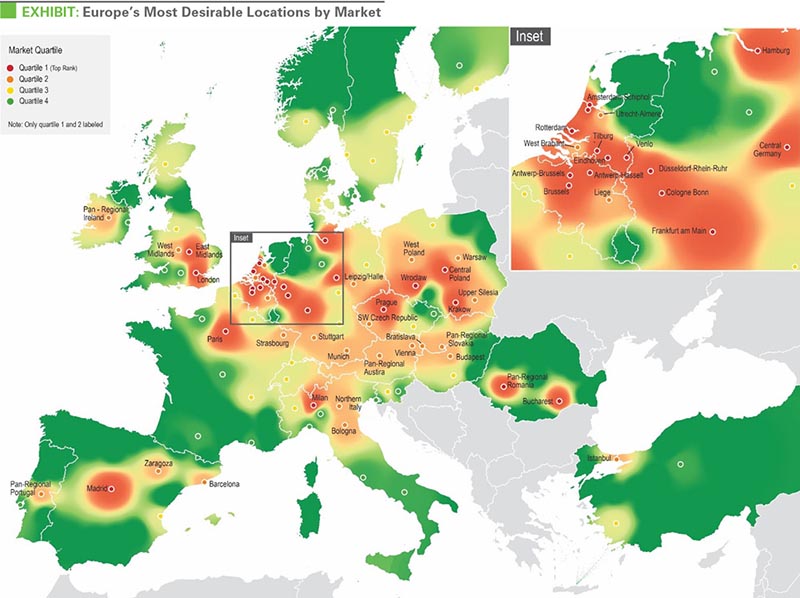
SECTION 2: THE MOST DESIRED LOCATIONS - BENELUX STILL HOT
Benelux and Western Germany the most favoured locations. Among the 100 locations in Europe, the most favoured are within the Benelux and Western Germany. Each of the top 5 locations are in the Benelux. A common theme is their capable “infrastructure”. In addition, these markets also scored well in their “proximity to customers and suppliers”. Among these highest ranked markets, Venlo is Europe’s most desirable location, a repeat of our 2013 survey and significantly ahead of other markets in our latest survey. Venlo scored best in 9 of the 11 location criteria, scoring particularly high for ‘availability of land’, ‘road access, ‘transport cost’ and ‘regulatory’.
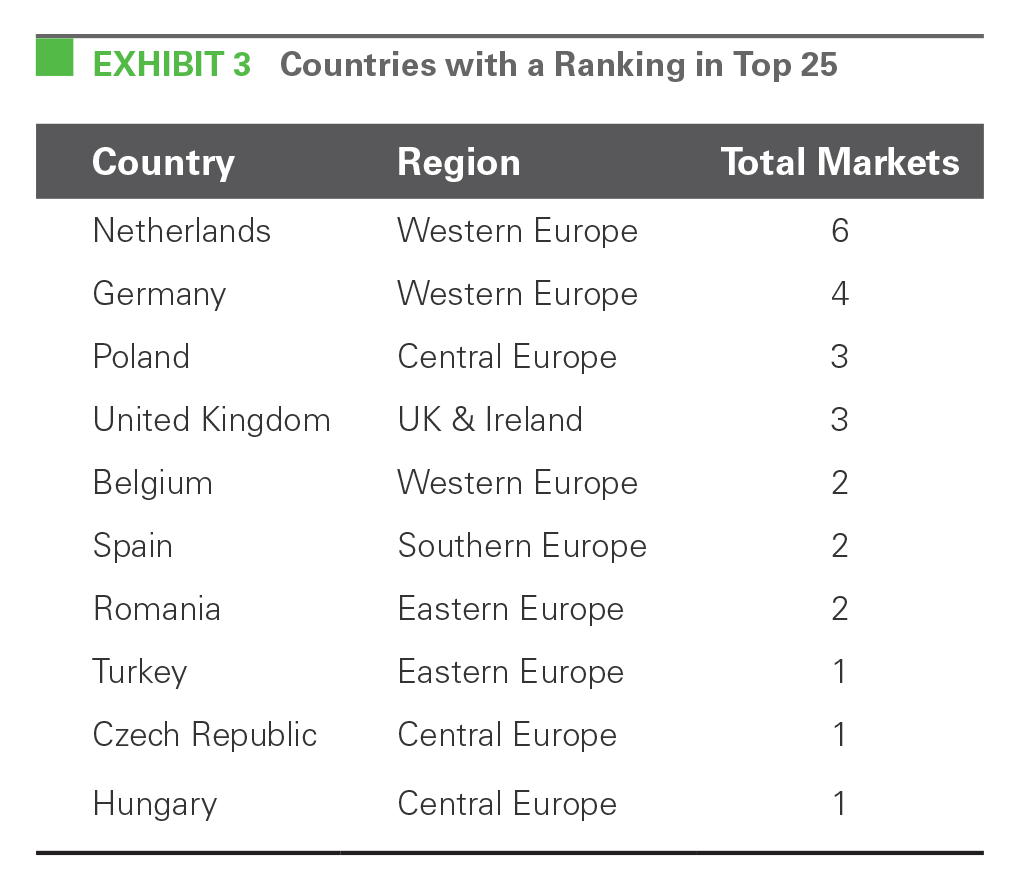
The biggest improvement is among locations in the CEE. Central Poland and Istanbul entered the top 10 and Prague (#11) is close. In total, eight CEE locations made it into the top 20 (compared to 4 in 2013). A choice within the CEE often boils down to balancing low cost and distance from customers. Low cost is a major factor; markets in CEE dominated the ranking in the criteria “cost of labor” and “real estate costs”. They continue to lack in criteria tied with infrastructure and proximity to customers and suppliers. Central Poland is the only location reaching a top 10 position in these two requirements.
The rise of markets in CEE is at the expense of markets located in Western Europe. Markets that showed the strongest declines in their ranking are Liege, Paris, and Central Germany. Air cargo hubs, like Frankfurt and Amsterdam-Schiphol, lost ground as well. According to the survey results, this is due to lower scores for the location drivers “labor availability” and “cost of labor”. Notable in its absence from the top quartile is France, Paris is found in the second quartile, reflecting a smaller appetite among customers for expansion in the coming years related to less supportive labor and government policies. Indeed, Paris is the last of the major markets to recover in Europe.
SECTION 3: HOW WILL LOCATION CHOICE CHANGE?
We asked survey respondents to address drivers of change. Exhibits 4, 5 and 6 detail their answers, which are accompanied with our analysis below. Among the details, forefront on customers’ minds are positioning their supply chains to:
- Attract staff
- Position for rising global trade volumes
- Capitalize on the benefits of logistics outsourcing
- Plan for the future, including addressing e-commerce and sustainability requirements
- The collective implication of all trends means greater consolidation rather than decentralization.
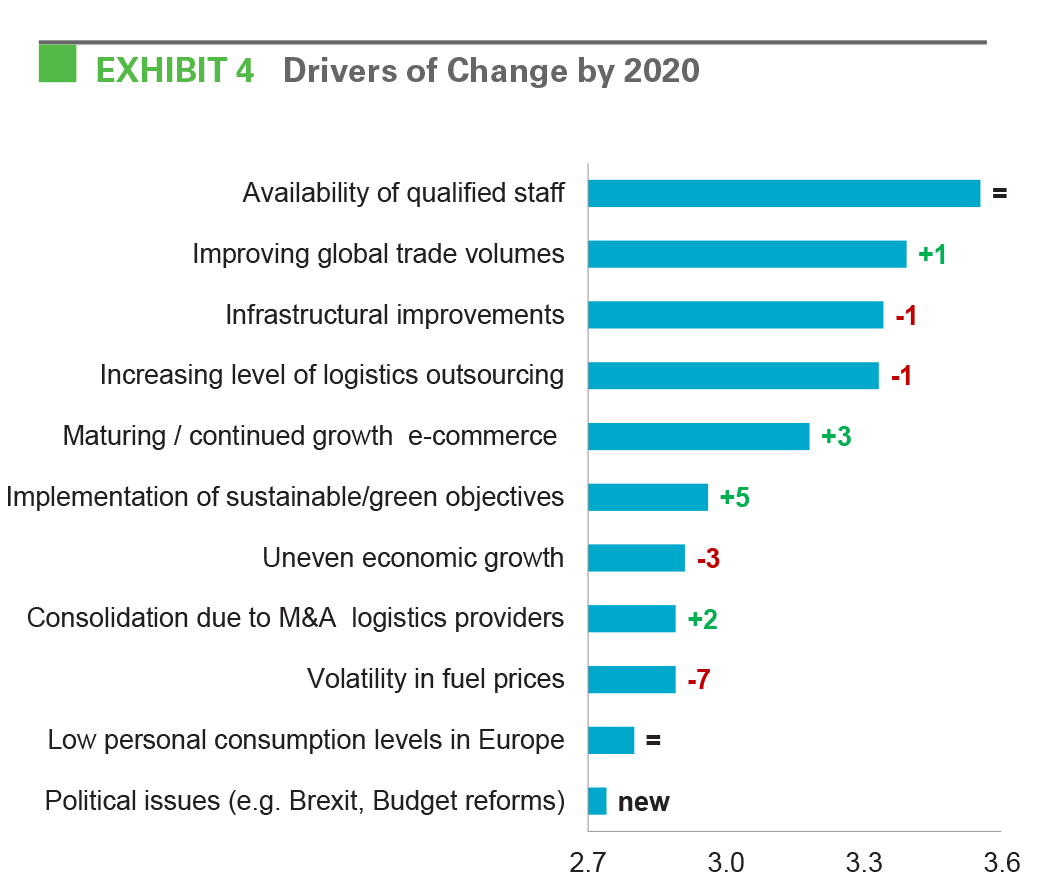
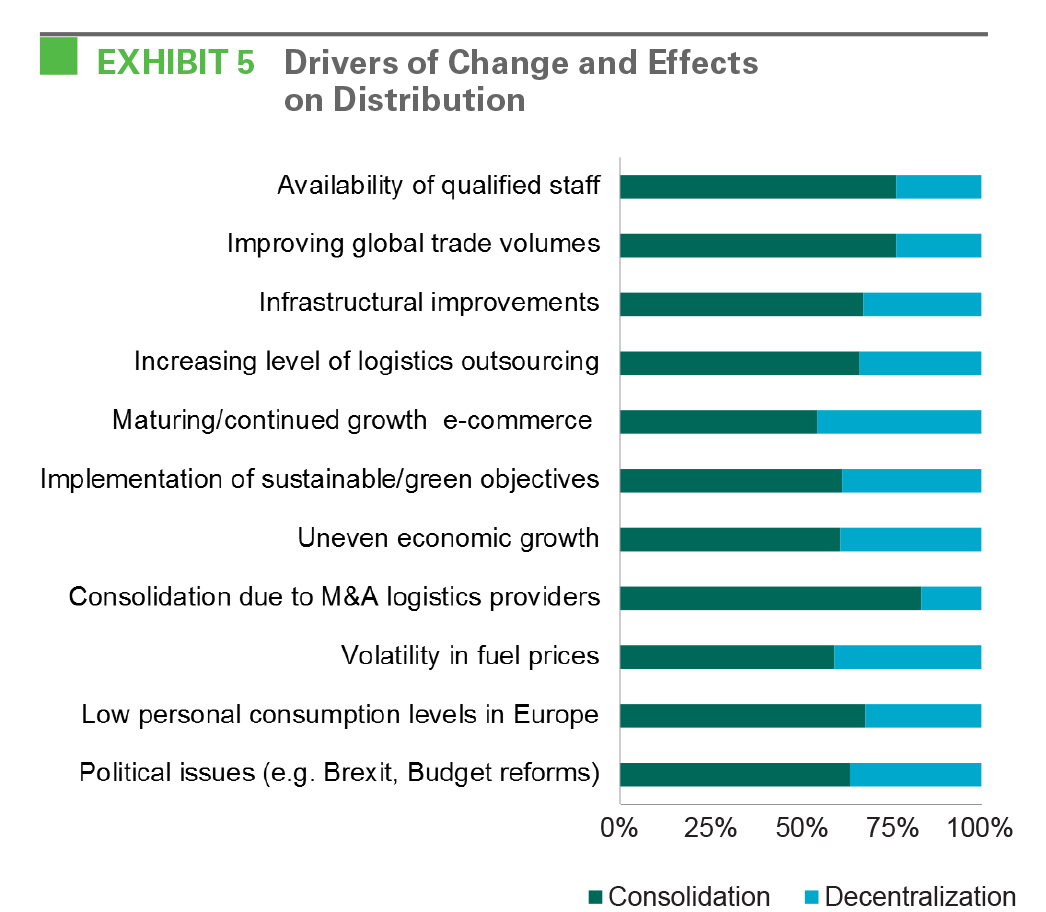
Availability of staff is the most important driver. However, the importance of this driver differs significantly per country-region in which the respondents are active. In general this driver is most important in Northwestern Europe and the United Kingdom and of less importance in the European periphery. However, across Europe it remains a challenge to find qualified and experienced staff.
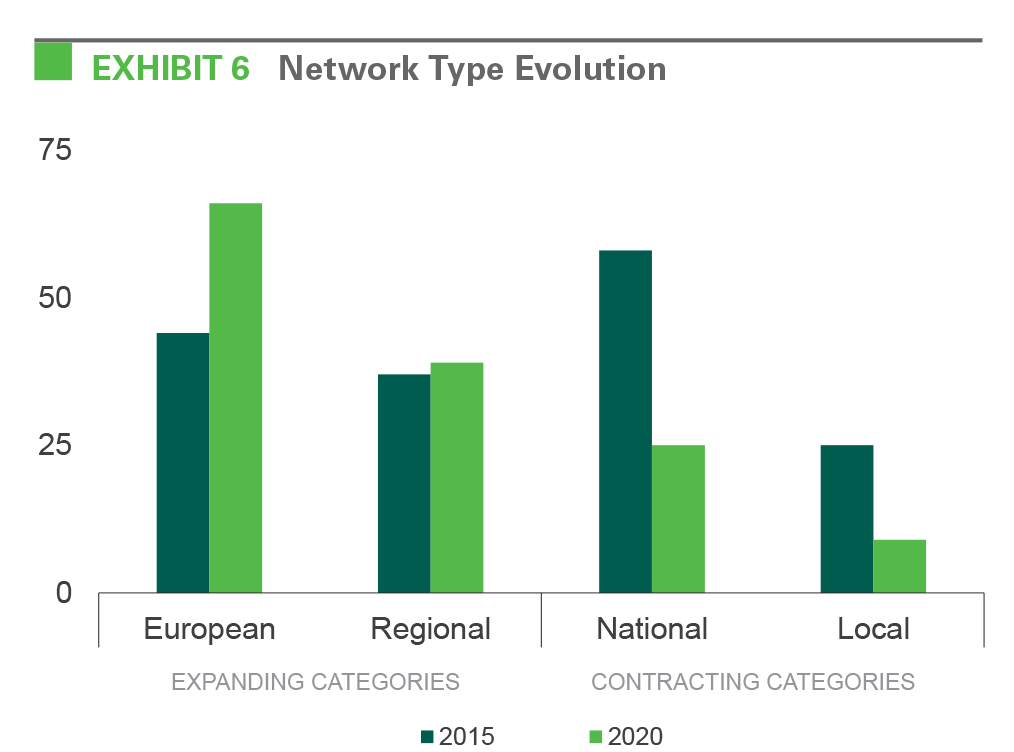
Main drivers of change are structural in nature. Factors, such as global trade, outsourcing and infrastructural improvements, appear poised to be stronger drivers of change than cyclical drivers, such as economic development and consumption. Availability of staff is the most important driver, which is likely both structural – the simple presence of people – and cyclical – the simple unemployment rate. Recent stricter border controls are a headline risk and indeed limit the free flow of goods. Yet, with respect to logistics real estate strategies, multiple other drivers such as the consolidation of inventories and the benefits of scale in a larger facilities, tempers the impact on location choice.
Shifting priorities increasingly emphasizing sustainability and e-commerce. Compared to our prior survey in 2013, two categories that were relatively unimportant at the time are now much more important: sustainability and planning for e-commerce. Sustainability has become particularly important for brand-sensitive customers, such as retailers and consumer packaged goods distributors. As for e-commerce, its growth has exploded in recent years and is only likely to become more important.
Priorities generally driving consolidation. All drivers of change are expected to lead to more consolidation of distribution networks. The strongest drivers of further consolidation of distribution network strategies are “M&A among logistics providers” (83% expect consolidation), “availability of qualified staff” and “improving global trade volumes” (both 76%). Expectations are that specifically “availability of qualified staff” and “global trade” lead to more consolidation as these are scored as the most important drivers of change in the coming five years.
Drivers of change with the highest allocation to decentralization are “e-commerce growth” (45% expects decentralization) and “volatility in fuel prices” (41%). E-commerce players have an increasing desire to be located closer to their end-customer which leads to a decentralization of their networks.
Consolidation expected to continue. Distribution networks are expected to expand further to a European network. Almost 45% of the respondents currently runs a distribution network, and this share is expected to increase to 66% by 2020. This is an increase of approximately 20% which is at the expense of National and Local networks. The prolongation of the consolidation trend leads to larger European networks and warehouse users looking for space at the key logistics hotspots to find a balance in the highest service levels for the lowest costs. Of note, buildings have been getting bigger for more than a decade, and indeed 60% of buildings started in 2015 were greater than 25,000 square metres and nearly 25% were larger than 50,000 square metres, and consolidation will only expand the trend.
CONCLUSION: WHAT DOES THIS MEAN IN THE LONGER TERM?
Logistics companies are constantly optimizing their distribution strategies to ensure the highest service levels for the lowest costs. The European market is driven by long term trends, such as proximity to economic networks, sourcing staffing and consolidation. The right location optimizes long-term opportunities for the growing footprint of warehouse users.
As distribution networks are expected to become more pan-European, markets in CEE become increasingly favourable for operations. This is driven by low costs factors for both employment and real estate and long term trends like the emergence of the middle-class. Although massive infrastructure improvements have been made in the past decade, infrastructure continues to lag behind the Western European standard. Once infrastructure improvements are in place and economic networks are better connected, more locations in CEE are expected to move further up the overall rankings.
In what type of locations will a warehouse user expand its footprint in the future? There are multiple factors driving this decision but well-connected locations with a pool of qualified staff close to economic networks are best positioned for the future. In addition, these locations need to be able to respond to new types of trends like the rise of e-commerce and sustainability innovations. These are preferable characteristics for investors and developers as well. However, to remain a favourable location for the investment community, a discipline in land allocation is needed.
To conclude, logistics corridors and infill locations in Europe’s largest metropolitan areas with high trade volumes and consumer demand are expected to benefit most from the expanding footprint.
FORWARD-LOOKING STATEMENTS
This material should not be construed as an offer to sell or the solicitation of an offer to buy any security. We are not soliciting any action based on this material. It is for the general information of customers of Prologis.
This report is based, in part, on public information that we consider reliable, but we do not represent that it is accurate or complete, and it should not be relied on as such. No representation is given with respect to the accuracy or completeness of the information herein. Opinions expressed are our current opinions as of the date appearing on this report only. Prologis disclaims any and all liability relating to this report, including, without limitation, any express or implied representations or warranties for statements or errors contained in, or omissions from, this report.
Any estimates, projections or predictions given in this report are intended to be forward-looking statements. Although we believe that the expectations in such forward-looking statements are reasonable, we can give no assurance that any forward-looking statements will prove to be correct. Such estimates are subject to actual known and unknown risks, uncertainties and other factors that could cause actual results to differ materially from those projected. These forward-looking statements speak only as of the date of this report. We expressly disclaim any obligation or undertaking to update or revise any forward-looking statement contained herein to reflect any change in our expectations or any change in circumstances upon which such statement is based.
No part of this material may be (i) copied, photocopied, or duplicated in any form by any means or (ii) redistributed without the prior written consent of Prologis.
PROLOGIS RESEARCH
Prologis’ research department studies fundamental and investment trends and Prologis’ customers’ needs to assist in identifying opportunities and avoiding risk across four continents. The team contributes to investment decisions and long-term strategic initiatives, in addition to publishing white papers and other research reports. Prologis publishes research on the market dynamics impacting Prologis’ customers’ businesses, including global supply chain issues and developments in the logistics and real estate industries. Prologis’ dedicated research team works collaboratively with all company departments to help guide Prologis’ market entry, expansion, acquisition and development strategies.
EFT
eft Supply Chain and Logistics Business Intelligence is the global leader in business intelligence and C-level networking for the transport, logistics and supply chain industry. For 16 years, eft has provided the industry with essential business intelligence in the form of news, reports, benchmarking data, white papers and C-level events. With our unique industry position, we’re able to leverage our global executive and expert contacts to produce unique high-level research, events, analysis and intelligence for the industry. www.eft.com.
ABOUT PROLOGIS
Prologis, Inc. is the global leader in industrial real estate. As of December 31, 2015, Prologis owned or had investments in, on a wholly owned basis or through co-investment ventures, properties and development projects expected to total approximately 669 million square feet (62 million square meters) in 20 countries. The company leases modern distribution facilities to more than 5,200 customers, including third-party logistics providers, transportation companies, retailers and manufacturers.
Copyright © 2016 Prologis, Inc. All rights reserved.

